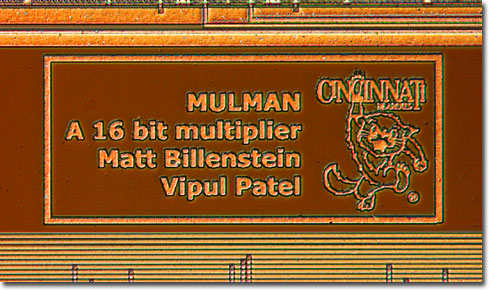Cincinnati Bearcats Multiplier
|
Electrical engineering students Matt Billenstein and Vipul Patel produced the Cincinnati Bearcat logo for a class project in VLSI (very large scale integration) design while undergraduates at the University. The chip functions as a 16-bit x 16-bit pipelined serial multiplier and was fabricated in 1.2-micrometer CMOS (complementary metal-oxide semiconductor) technology. With a clock speed of 30 MHz, the multiplier is capable of a throughput equal to roughly 1 million multiplies per second. View the Cincinnati Bearcats logo in brightfield illumination and darkfield illumination. Mythology surrounding the origins of the University of Cincinnati's bearcat logo is as convoluted as the tales swirling among its many generations of alumni and fans. Was it the reigning sports car of the pre-World War I era, the Studz Bearcat automobile, or perhaps an Asiatic carnivore featured at the Cincinnati Zoo? According to experts, the University of Cincinnati's football team did not sport a nickname until 1914 when it was scheduled to play the University of Kentucky Wildcats in the fifth game of a nine-game schedule. Previously known only loosely as the "Cincinnati Eleven", the "Red & Black", "Dana's Boys", or the "Little Boys", a specific mascot had not been pinned to the school, and, in general, mascots were uncommon among college football teams at the turn of the twentieth century. Legend has it that a cheerleader, Norman "Pat" Lyon created a new cheer based on the valiant efforts of fullback Leonard K. "Teddy" Baehr against the Wildcat powerhouse: "They may be Wildcats, but we have a Baehr-cat on our side." The crowd caught on with a cry of "Come on, Baehr-cat", the University of Cincinnati pulled off an upset, and the victory was memorialized on the front page of the school paper with a new cartoon creature, labeled the "Cincinnati Bear Cats". The name was popular but then faded until 1919 when the Cincinnati Enquirer sent Jack Ryder to cover a big game. He called the football team the "Bearcats" in his story, and the name and logo stuck ever since. Other schools have since adopted the mythical bearcat as their school mascot. |
© 1995-2025 by Michael W. Davidson and The Florida State University. All Rights Reserved. No images, graphics, software, scripts, or applets may be reproduced or used in any manner without permission from the copyright holders. Use of this website means you agree to all of the Legal Terms and Conditions set forth by the owners.
This website is maintained by our
|
